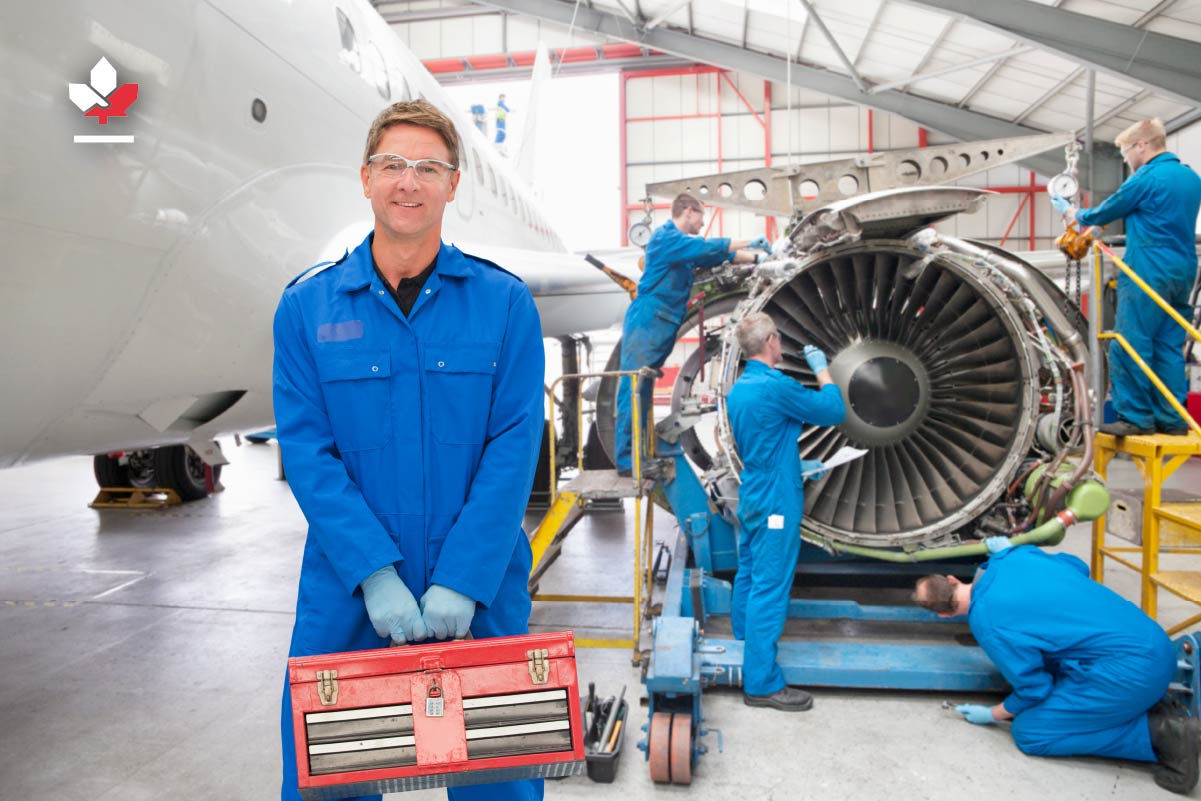Find a Job in the Aerospace Industry in Canada
August 23, 2024
|
Finding a job in Canada's aerospace industry offers a gateway to a dynamic and thriving sector known for its innovation and growth. As Canada continues to be a global leader in aerospace technology, professionals in this field are in high demand. Whether you are an experienced engineer, a skilled technician, or a recent graduate, navigating the job market requires strategic planning and a clear understanding of the sector’s demands.
Preparing to work in Canada’s aerospace industry? Then, take a look at the key steps and practical advice for securing a position in Canada’s aerospace industry.
Canada’s Aerospace Industry

Canada’s aerospace industry, the world’s seventh most significant, is a vital sector within the national economy, renowned for its innovation and global impact. With a workforce of approximately 218,000 professionals, the industry significantly contributes to Canada's Gross Domestic Product (GDP), valued at over 29 billion CAD annually, according to the Aerospace Industries Association of Canada (AIAC). Major hubs include Montreal, Toronto, and Vancouver, with key players such as Bombardier, Pratt & Whitney Canada, and CAE leading the way. Key strengths of Canada's aerospace industry include:
Canada’s aerospace sector remains a global leader, ranking in the top five for civil flight simulators, engines, and aircraft, showcasing its diverse product offerings. Notably, the industry is led in research and development among Canadian manufacturers, with Research and Development (R&D) spending rebounding to pre-pandemic figures.
The Canadian aerospace manufacturing industry exported over 19 billion CAD in global trade, with more than 75% of its revenues coming from exports and nearly 60% tied to global supply chains. This strong performance highlights the sector's vital role in the national economy and international aerospace markets.
How Can I Find an Aerospace Industry Job in Canada?

The aerospace industry in Canada is a dynamic and growing field, offering a range of opportunities for skilled professionals. If you aim to secure a job in this exciting industry, here is a detailed guide to help you navigate the process.
Step 1: Research the Aerospace Sector
Before diving into the job search, it is crucial to understand the aerospace sector in Canada. The industry is known for its innovation and technological advancements, with key players including Bombardier, Pratt & Whitney, and CAE. Research these companies to understand their core activities, recent projects, and areas of expertise. You should also familiarize yourself with the sector’s trends, such as advancements in aerospace technology and evolving market demands. This knowledge will help you target the right companies and roles that align with your career goals.
Step 2: Tailor Your Resume and Cover Letter
Your Canadian resume and cover letter are your primary tools for making a solid first impression. Craft your Canadian cover letter and resume specifically for aerospace positions by emphasizing relevant skills, experience, and achievements. Highlight any experience with aerospace technologies, engineering principles, or aircraft maintenance. Use industry-specific terminology and quantify your accomplishments with metrics when possible. A well-crafted Canadian resume and cover letter demonstrate your understanding of the aerospace field and how you are a perfect fit for the role you are applying for.
Step 3: Network Within the Industry
Building connections can lead to job opportunities that are not advertised publicly. You must attend industry conferences, trade shows, and workshops to meet professionals and potential Canadian employers. Join aerospace associations and groups like the AIAC. Online networking platforms like LinkedIn are also valuable for connecting with industry professionals and joining relevant groups and discussions.
Step 4: Use Job Portals and Company Websites
Make sure to use job portals and company websites to find job openings in the aerospace sector. Major job boards like Indeed and Glassdoor often list aerospace positions. You should also visit the career pages of key aerospace companies to find direct listings and application instructions. Many companies also post job opportunities on industry-specific job boards. Set up job alerts on these platforms to receive notifications about new postings that match your criteria.
Step 5: Obtain Necessary Certifications and Qualifications
Specific certifications and qualifications are required for many aerospace industry positions. Depending on the role, this might include certifications in aerospace engineering, avionics, or aircraft maintenance. Ensure you have the necessary credentials by checking job descriptions for required qualifications.
Step 6: Apply Strategically
When applying for jobs, you must be strategic in your approach. Focus on positions that are in line with your skills and experience, and write each application to the specific job and company. Follow application instructions carefully, and ensure your Canadian resume and cover letter are customized for each role. Highlight your most relevant experiences and achievements directly related to the job description.
Step 7: Prepare for Interviews
Preparation is critical to making a positive impression if you are selected for an interview. Research the company thoroughly, including its history, products, and recent developments. Understand the role you are interviewing for and how your background aligns with the job requirements. Practice answering common interview questions related to aerospace roles, and be ready to discuss technical skills, problem-solving abilities, and industry knowledge. Demonstrating your preparedness and enthusiasm for the role will help you prove why you are the best candidate.
Step 8: Stay Informed
The aerospace industry constantly evolves, so staying informed about industry trends and developments is crucial. Subscribe to aerospace industry publications, follow relevant news sources, and participate in industry forums. Keeping up with trends such as advancements in aircraft technology, regulatory changes, and market dynamics will help you in job interviews and understand the broader context of your role within the industry. Staying informed will also help you adapt to changes and seize new opportunities as they arise.
What Are the Benefits of Working in Canada’s Aerospace Industry?

Canada's aerospace industry offers many benefits for professionals seeking rewarding careers. Here are some of the key advantages.
Competitive Salaries and Benefits
Aerospace professionals in Canada enjoy competitive salaries, often higher than average engineering or technical roles. According to Canada’s Job Bank, aerospace engineers and technicians can expect to earn an annual average salary of 122,251.21 CAD and 84,766.03 CAD, depending on experience and specialization. The industry typically offers comprehensive benefits packages, including health insurance, retirement plans, and performance bonuses.
Learn more about Canada’s benefits via its Social Insurance Number (SIN).
Innovation and Technology
Working in Canada’s aerospace sector provides exposure to cutting-edge technologies and innovative projects. The industry is a leader in developing advanced avionics, aircraft systems, and flight simulators. Employees often work on high-profile projects, contributing to advancements in aviation and space exploration.
Learn about the emerging tech cities in Canada you can move to as an aerospace engineer.
Strong Industry Network
Canada’s aerospace industry is home to numerous leading firms and research institutions, providing ample networking opportunities. Engaging with industry leaders, attending conferences, and participating in professional associations help build valuable connections and expand career prospects. Among the most prominent aerospace industry associations you can contact in Canada include:
- Aerospace Industries Association of Canada (AIAC),
- Canadian Council for Aviation & Aerospace (CCAA),
- Women in Aerospace Canada (WIA-Canada),
- Canadian Business Aviation Association (CBAA),
- Canadian Space Commerce Association (CSCA),
- Royal Aeronautical Society Montreal Branch (RAeS), and
- Canadian Owners & Pilots Association (COPA).
Supportive Work Environment
Canadian aerospace companies are known for their inclusive and collaborative work environments. Companies prioritize employee well-being, work-life balance, and diversity, fostering a supportive atmosphere that facilitates career satisfaction and productivity.
FAQs
What Are the Challenges of Working in the Aerospace Industry?
The aerospace industry often involves high-pressure environments with tight deadlines and stringent safety regulations. Professionals may face challenges related to complex technical problems and the need for continuous learning to keep up with rapid technological advancements.
What Are the Opportunities for Career Growth in the Aerospace Industry?
Career growth in the aerospace industry includes opportunities for advancement into specialized technical roles, project management, and leadership positions. With ongoing technological advancements and a focus on innovation, professionals can pursue roles in emerging fields like autonomous systems and space exploration.
What is the Application Process for Aerospace Jobs in Canada?
The application process for aerospace jobs in Canada typically begins with tailoring your resume and cover letter to highlight relevant experience and skills. Next, submit your application through job portals or directly on company websites and prepare for potential interviews.
How Can I Immigrate to Canada as an Aerospace Industry Worker?
To immigrate to Canada as an aerospace industry worker, you typically need to apply through one of Canada’s economic immigration programs, such as the Express Entry system's Federal Skilled Worker Program (FSWP). Ensure you have relevant work experience and qualifications in the aerospace field, as well as a valid job offer or a Provincial Nominee Program (PNP) nomination if applicable.
